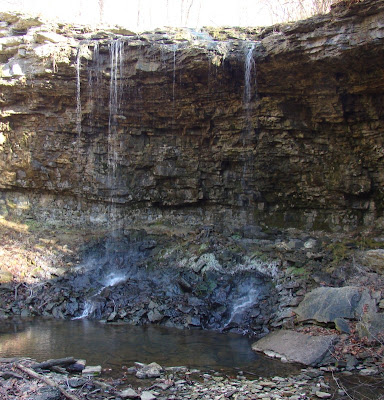
And if you go to see the Say's, remember there are some fantastic natural areas to visit in the surrounding areas.
 A mere 20 minutes from Yellow Springs is Charleston Falls, a park in Miami County. Jim Davidson and Janet Creamer recently gave me the grand tour, complete with bad puns and dormant plant identification. The trails are well-maintained, with boardwalks, stair cases and bridges making reasonably easy access to this rock canyon with a good assortment of mosses and ferns for winter botanists.
A mere 20 minutes from Yellow Springs is Charleston Falls, a park in Miami County. Jim Davidson and Janet Creamer recently gave me the grand tour, complete with bad puns and dormant plant identification. The trails are well-maintained, with boardwalks, stair cases and bridges making reasonably easy access to this rock canyon with a good assortment of mosses and ferns for winter botanists. The water splashing on the vegetation created up-side-down icicles (ice stalagmites?) that glistened like white fringe in the sunlight. These moments of magic can only come from cold weather.
The water splashing on the vegetation created up-side-down icicles (ice stalagmites?) that glistened like white fringe in the sunlight. These moments of magic can only come from cold weather. Winter? Bring it on!








 The Grange Audubon Center, photo by Tom Arbour -
The Grange Audubon Center, photo by Tom Arbour - 
.jpg)





 So they booked the Holiday, a boat a bit smaller than the ship we passed in the channel..
So they booked the Holiday, a boat a bit smaller than the ship we passed in the channel..









 Ocotillo is the deadest, prickliest-looking plant you can imagine in October, so it was interesting to learn of its value to hummers. Never under estimate the value of worthless-looking plants!
Ocotillo is the deadest, prickliest-looking plant you can imagine in October, so it was interesting to learn of its value to hummers. Never under estimate the value of worthless-looking plants! One parting shot, and a beauty he was. Care to make a guess at the species?
One parting shot, and a beauty he was. Care to make a guess at the species?

